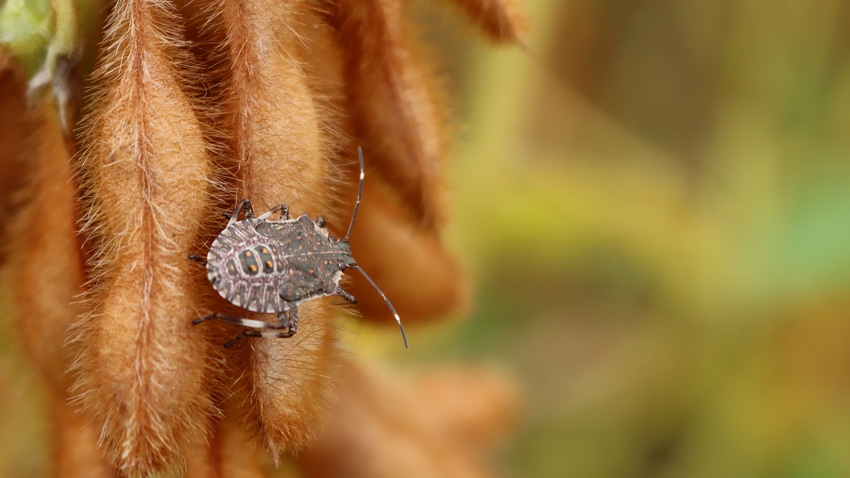
Anders Huseth encourages farmers to think like a stinkbug when managing this troublesome pest in soybeans and other crops. The key is to understand the ecology and migration patterns of the insect.
“Brown stinkbugs and green stinkbugs tend to overwinter in protected areas like forests. Then they move into their next host. Those stinkbug populations will move into a very suitable early season host. One that is really important is early season crop host is wheat,” said Huseth, North Carolina State University Extension entomologist, Feb. 13 at the Soybean School at the Maxwell Center in Goldsboro.
Huseth said stinkbugs then often choose to move to adjacent full-season crops like soybean or corn after grain dries down. Adjacent fields can get pulses of the insect infestations along the edges of corn and soybean fields, where they move from the wheat to their next crop. The stinkbugs then dilute into the rest of the field.
“These are places in which you can target scouting to try to understand and use that landscape to your advantage, knowing that there are a lot of stinkbugs likely coming out of wheat fields and moving into the next suitable host. So, thinking more like a stinkbug is important here, and thinking about places you might need to scout more diligently, particularly in crops like full season soybean or corn,” Huseth said.
Later in the season, stinkbugs move onto late season crops (cotton, double crop soybean) or weeds where they will feed on that weedy host and eventually immigrate back into the forested habitat where they will overwinter again in the season.
“This local movement pattern is important to consider as we try to target stinkbug populations, knowing the places where they move through the habitat, through the landscape is critical for being able to effectively scout,” Huseth said.
Varied insecticide responses
Huseth said several of these stinkbug species respond differently to different insecticides. The brown stinkbug is less susceptible to some pyrethroids than other stink bug species.
Southern green stinkbugs are easier to kill with some pyrethroids. Brown stinkbugs require higher rates of pesticides, such as bifenthrin. That’s why it’s important to identify what species you have in your fields to plan proper treatment.
Huseth said it is important to understand why stinkbugs have become a problem in soybeans and why true bugs or tarnished plant bugs have become a problem in cotton.
“Over the past 50 years, we’ve had an increase in broad-spectrum insecticides and now a decrease. Now we have insecticides that are more specific in the mix targeting our key pests. We have eradicated the boll weevil, an insect that was sprayed widely in cotton,” Huseth said.
“A lot of the sprays that targeted boll weevil also likely suppressed some of these true bug populations, and at the same time, since the mid-1990s, we’ve seen an adoption of transgenic crops. The result is there is essentially less insecticide in the system and more favorable conditions for secondary pests. We think this is one explanation for why we’ve seen this recent increase in these true bug species across the southern U.S.,” he said.
Huseth said tarnished plant bugs are primarily a cotton pest. In contrast, the whole complex of stink bugs — including brown stinkbugs, green stinkbugs, Southern green stinkbugs, brown marmorated stinkbugs and a host of others — are common soybean pests. Across the United States, 28% of insect related losses in soybeans can be attributed to stinkbugs, particularly, brown stinkbugs, green stinkbugs, and red banded stinkbugs further south.
Continuing research
Since 2022, Huseth and his team have conducted research across North Carolina to determine how abundant stinkbugs are at the field level and what parts of the field have the highest densities of the pest. By the end of 2024, they will have sampled 90 fields — from mountains to sea, as well as 30 fields throughout Virginia.
The goal is to deliver a comprehensive set of species identifications of stinkbugs in North Carolina and Virginia and provide effective scouting recommendations so farmers can determine their best control options.
N.C. State will continue updating its pesticide application recommendations following the completion of the research to see which products are most effective on the various stink bug species. The goal is to avoid insecticide resistance.
“If you repeat and use the same insecticide time and time again, the end result is you get a population of resistant bugs. We want to break this cycle up by rotating insecticide modes of action.” Huseth said.
About the Author(s)
You May Also Like






